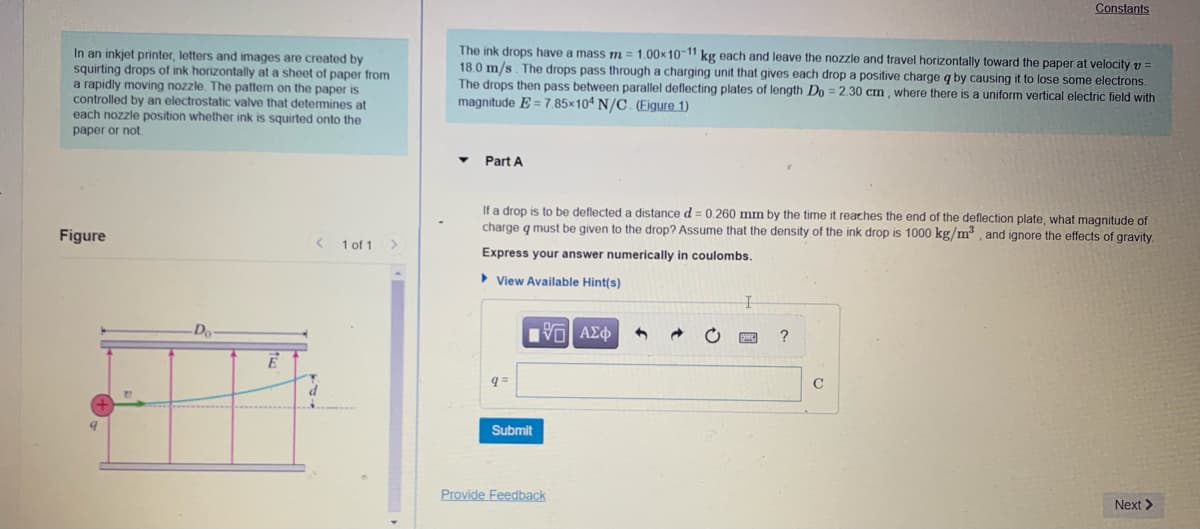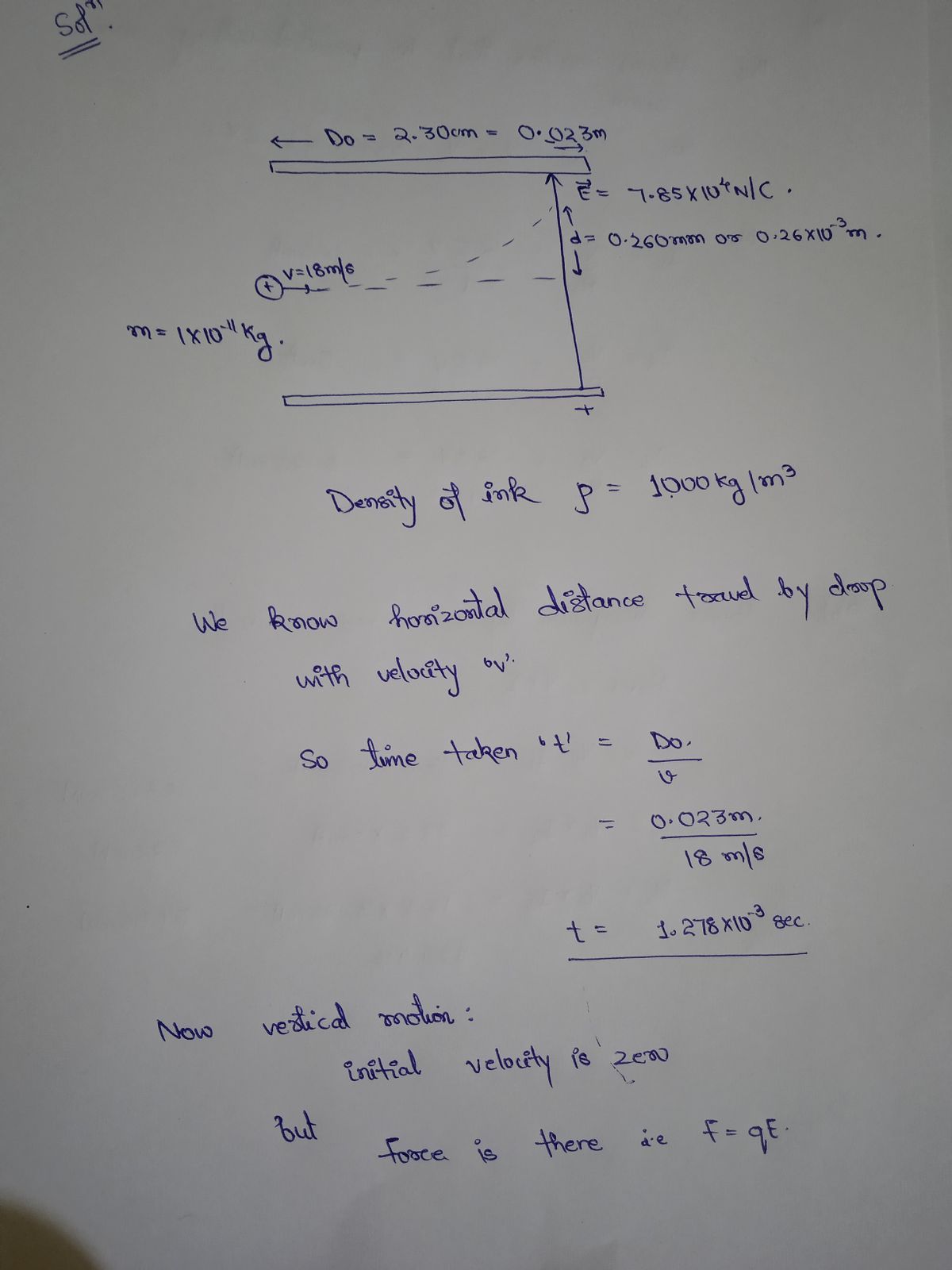In an inkjet printer, letters and images are created by mass m = 1.00x10 kg each and leave the nozzle and travel horizontally toward the paper at velocity v = squirting drops of ink horizontally at a sheet of paper from a rapidly moving nozzle. The pattern on the paper is controlled by an electrostatiC valve that determines at each nozzle position whether ink is squirted onto the 18.0 m/s. The drops pass through a charging unit that gives each drop a positive charge q by causing it to lose some electrons. The drops then pass between parallel deflecting plates of length Do 2.30 cm , where there is a uniform vertical electric field with magnitude E = 7.85×104 N/C. (Eigure 1) paper or not Part A If a drop is to be deflected a distance d = 0.260 mm by the time it reaches the end of the deflection plate, what magnitude of charge q must be given to the drop? Assume that the density of the ink drop is 1000 kg/m, and ignore the effects of gravity Figure 1 of 1 > Express your answer numerically in coulombs. > View Available Hint(s) D ? C Submit Provide Feedback Next>
In an inkjet printer, letters and images are created by mass m = 1.00x10 kg each and leave the nozzle and travel horizontally toward the paper at velocity v = squirting drops of ink horizontally at a sheet of paper from a rapidly moving nozzle. The pattern on the paper is controlled by an electrostatiC valve that determines at each nozzle position whether ink is squirted onto the 18.0 m/s. The drops pass through a charging unit that gives each drop a positive charge q by causing it to lose some electrons. The drops then pass between parallel deflecting plates of length Do 2.30 cm , where there is a uniform vertical electric field with magnitude E = 7.85×104 N/C. (Eigure 1) paper or not Part A If a drop is to be deflected a distance d = 0.260 mm by the time it reaches the end of the deflection plate, what magnitude of charge q must be given to the drop? Assume that the density of the ink drop is 1000 kg/m, and ignore the effects of gravity Figure 1 of 1 > Express your answer numerically in coulombs. > View Available Hint(s) D ? C Submit Provide Feedback Next>
Classical Dynamics of Particles and Systems
5th Edition
ISBN:9780534408961
Author:Stephen T. Thornton, Jerry B. Marion
Publisher:Stephen T. Thornton, Jerry B. Marion
Chapter9: Dynamics Of A System Of Particles
Section: Chapter Questions
Problem 9.63P
Related questions
Question

Transcribed Image Text:Constants
In an inkjet printer, letters and images are created by
squirting drops of ink horizontally at a sheet of paper from
a rapidly moving nozzle. The patten on the paper is
controlled by an electrostatic valve that determines at
each nozzle position whether ink is squirted onto the
paper or not
The ink drops have a mass m = 1.00x10-11 kg each and leave the nozzle and travel horizontally toward the paper at velocity v =
18.0 m/s. The drops pass through a charging unit that gives each drop a positive charge q by causing it to lose some electrons.
The drops then pass between parallel deflecting plates of length Do = 2.30 cm , where there is a uniform vertical electric field with
magnitude E = 7.85×10ª N/C . (Eigure 1)
Part A
If a drop is to be deflected a distance d = 0.260 mm by the time it reaches the end of the deflection plate, what magnitude of
charge q must be given to the drop? Assume that the density of the ink drop is 1000 kg/m, and ignore the effects of gravity.
Figure
< 1 of 1 >
Express your answer numerically in coulombs.
> View Available Hint(s)
Do
q =
Submit
Provide Feedback
Next >
Expert Solution
Step 1

Trending now
This is a popular solution!
Step by step
Solved in 2 steps with 2 images

Knowledge Booster
Learn more about
Need a deep-dive on the concept behind this application? Look no further. Learn more about this topic, physics and related others by exploring similar questions and additional content below.Recommended textbooks for you

Classical Dynamics of Particles and Systems
Physics
ISBN:
9780534408961
Author:
Stephen T. Thornton, Jerry B. Marion
Publisher:
Cengage Learning

Principles of Physics: A Calculus-Based Text
Physics
ISBN:
9781133104261
Author:
Raymond A. Serway, John W. Jewett
Publisher:
Cengage Learning

Physics for Scientists and Engineers with Modern …
Physics
ISBN:
9781337553292
Author:
Raymond A. Serway, John W. Jewett
Publisher:
Cengage Learning

Classical Dynamics of Particles and Systems
Physics
ISBN:
9780534408961
Author:
Stephen T. Thornton, Jerry B. Marion
Publisher:
Cengage Learning

Principles of Physics: A Calculus-Based Text
Physics
ISBN:
9781133104261
Author:
Raymond A. Serway, John W. Jewett
Publisher:
Cengage Learning

Physics for Scientists and Engineers with Modern …
Physics
ISBN:
9781337553292
Author:
Raymond A. Serway, John W. Jewett
Publisher:
Cengage Learning

Physics for Scientists and Engineers
Physics
ISBN:
9781337553278
Author:
Raymond A. Serway, John W. Jewett
Publisher:
Cengage Learning

Glencoe Physics: Principles and Problems, Student…
Physics
ISBN:
9780078807213
Author:
Paul W. Zitzewitz
Publisher:
Glencoe/McGraw-Hill

An Introduction to Physical Science
Physics
ISBN:
9781305079137
Author:
James Shipman, Jerry D. Wilson, Charles A. Higgins, Omar Torres
Publisher:
Cengage Learning